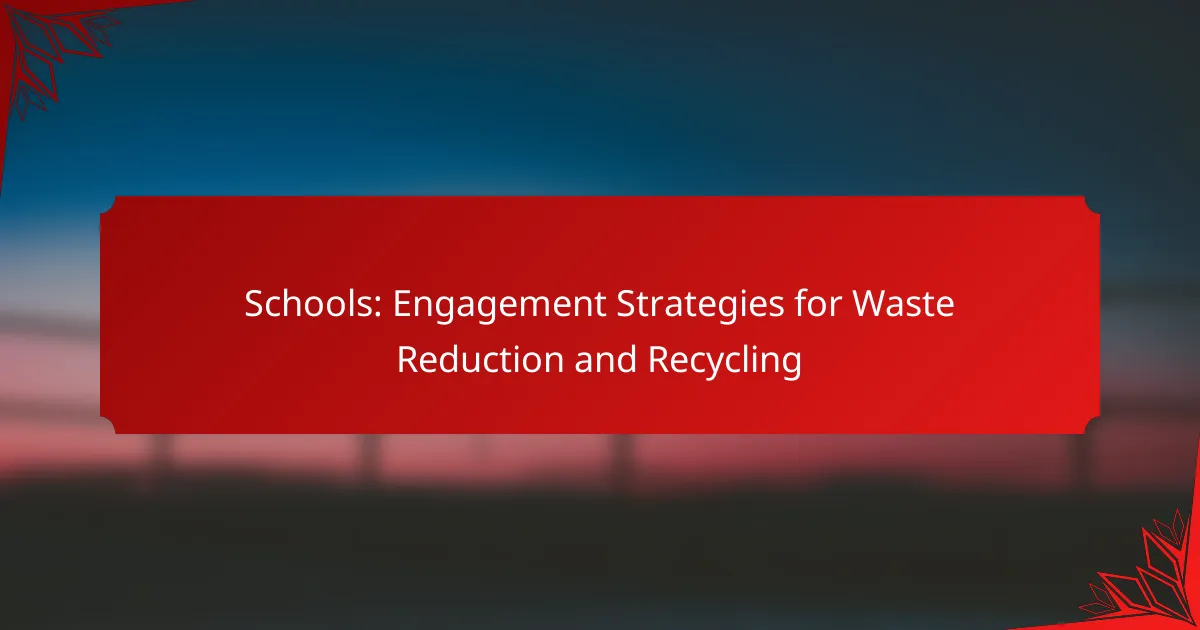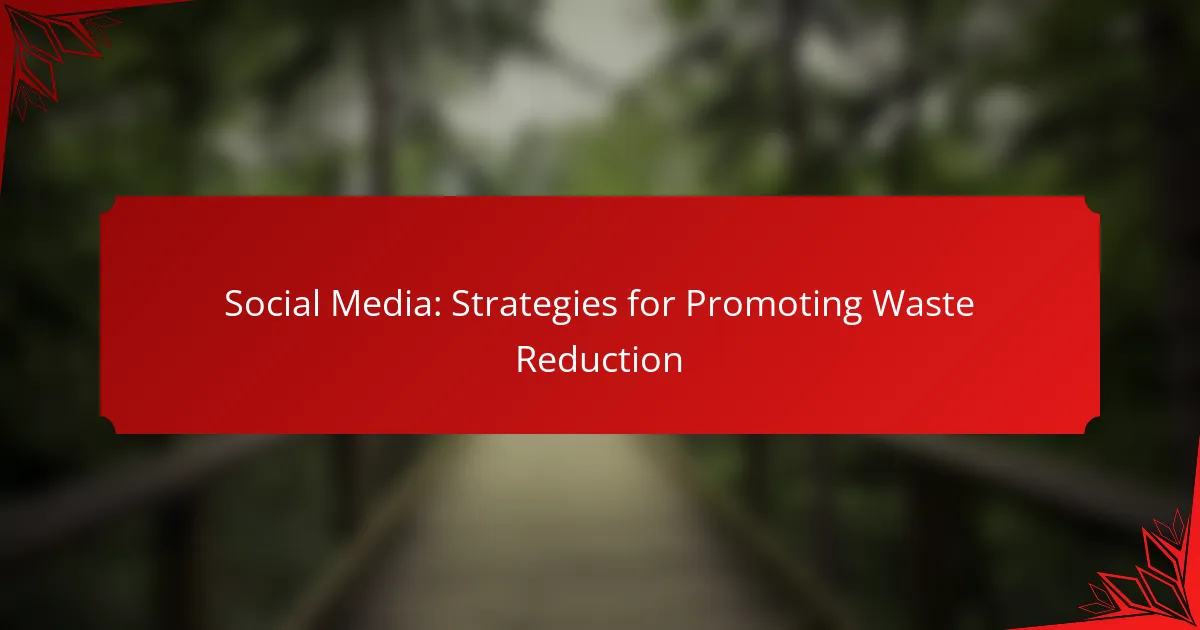Engaging students, staff, and the community in waste reduction and recycling initiatives is essential for fostering a culture of sustainability in schools. By implementing clear strategies, such as designated recycling stations and educational programs, schools can significantly reduce waste while promoting environmental responsibility. These efforts not only lead to financial savings but also enhance awareness and positively impact the broader community.
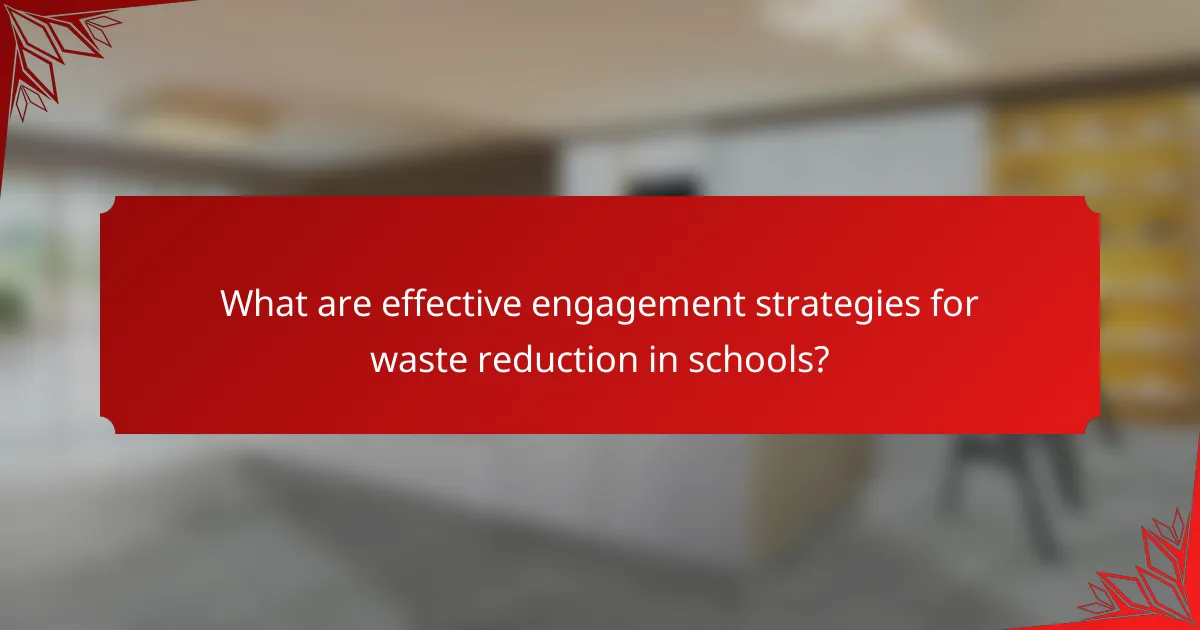
What are effective engagement strategies for waste reduction in schools?
Effective engagement strategies for waste reduction in schools include initiatives that actively involve students, staff, and the community in sustainable practices. These strategies foster a culture of responsibility and awareness around waste management and recycling.
Student-led recycling initiatives
Student-led recycling initiatives empower learners to take charge of waste management in their schools. By forming recycling clubs or committees, students can organize collection drives, create educational materials, and promote recycling practices among their peers.
These initiatives can be enhanced by setting up visible recycling stations around the school, making it easier for students to participate. Schools can also encourage friendly competitions between classes to see who can recycle the most, fostering a sense of community and accountability.
Community clean-up events
Community clean-up events engage students and local residents in hands-on activities that promote environmental stewardship. Schools can partner with local organizations to host clean-up days at parks, beaches, or neighborhoods, allowing students to see the direct impact of their efforts.
These events not only help reduce litter but also build a sense of community pride. Schools can incentivize participation by offering service hours or recognition awards, encouraging students to contribute actively to their surroundings.
Interactive workshops on sustainability
Interactive workshops on sustainability provide students with practical knowledge and skills related to waste reduction and recycling. These workshops can cover topics such as composting, upcycling, and the importance of reducing single-use plastics.
Inviting local experts or environmental organizations to lead these sessions can enhance engagement. Schools can also incorporate hands-on activities, like creating compost bins or DIY projects, to make learning about sustainability enjoyable and memorable.
Incentive programs for waste reduction
Incentive programs for waste reduction motivate students to adopt sustainable habits by rewarding positive behaviors. Schools can implement systems where students earn points or tokens for recycling, reducing waste, or participating in eco-friendly activities.
These points can be exchanged for rewards such as school merchandise, extra recess time, or recognition at school assemblies. By providing tangible benefits, schools can encourage ongoing participation in waste reduction efforts and create a culture of sustainability.
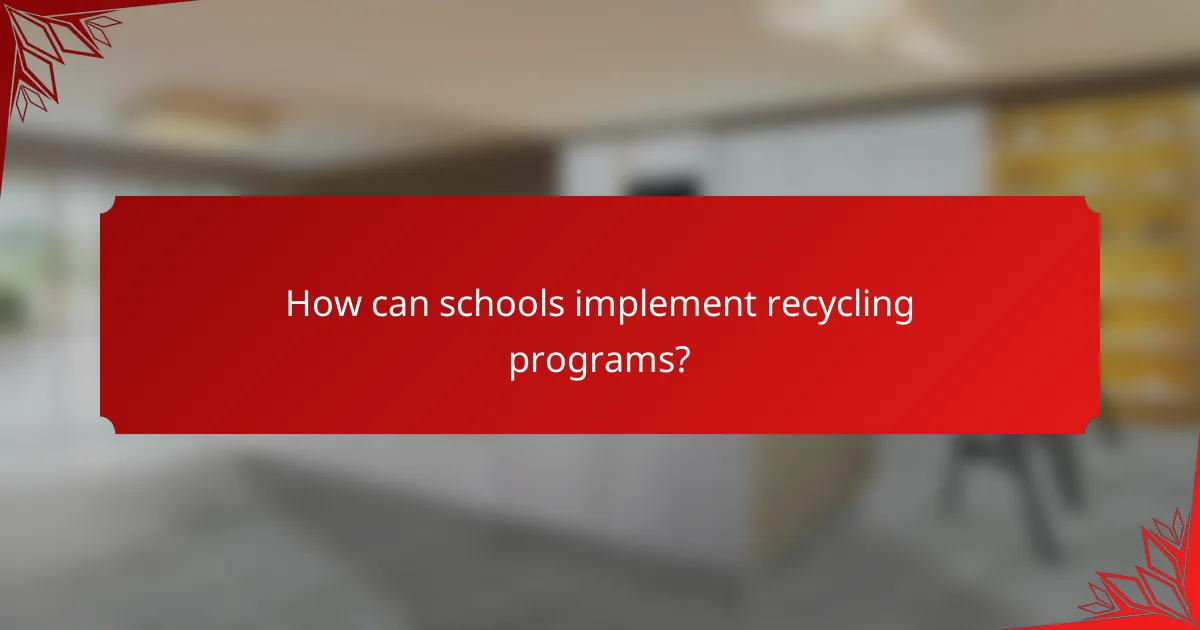
How can schools implement recycling programs?
Schools can implement recycling programs by establishing clear strategies that engage students and staff in waste reduction. This includes forming partnerships, creating designated recycling stations, and integrating recycling education into the curriculum.
Partnerships with local recycling facilities
Forming partnerships with local recycling facilities is crucial for effective recycling programs in schools. These partnerships can provide resources, guidance, and support for managing recyclable materials. Schools should reach out to nearby facilities to understand their requirements and services.
Additionally, collaborating with local businesses can enhance recycling efforts. For example, schools might arrange for regular pickups of recyclables or participate in community recycling events, fostering a sense of responsibility among students.
Establishing recycling stations on campus
Setting up recycling stations throughout the campus is essential for encouraging participation in recycling programs. Stations should be clearly labeled and easily accessible, with separate bins for different materials such as paper, plastics, and metals. This organization helps reduce contamination and improves the efficiency of recycling efforts.
Schools can also consider placing educational signage near recycling stations to inform students about what can and cannot be recycled. Regular monitoring and maintenance of these stations will ensure they remain effective and encourage ongoing use.
Curriculum integration of recycling education
Integrating recycling education into the curriculum helps students understand the importance of waste reduction and recycling. Lessons can cover topics such as the recycling process, the environmental impact of waste, and practical ways to reduce waste in daily life.
Hands-on activities, such as projects that involve creating art from recycled materials or organizing school-wide recycling competitions, can enhance engagement. Schools should aim to make recycling education a fun and interactive part of the learning experience, fostering a culture of sustainability among students.
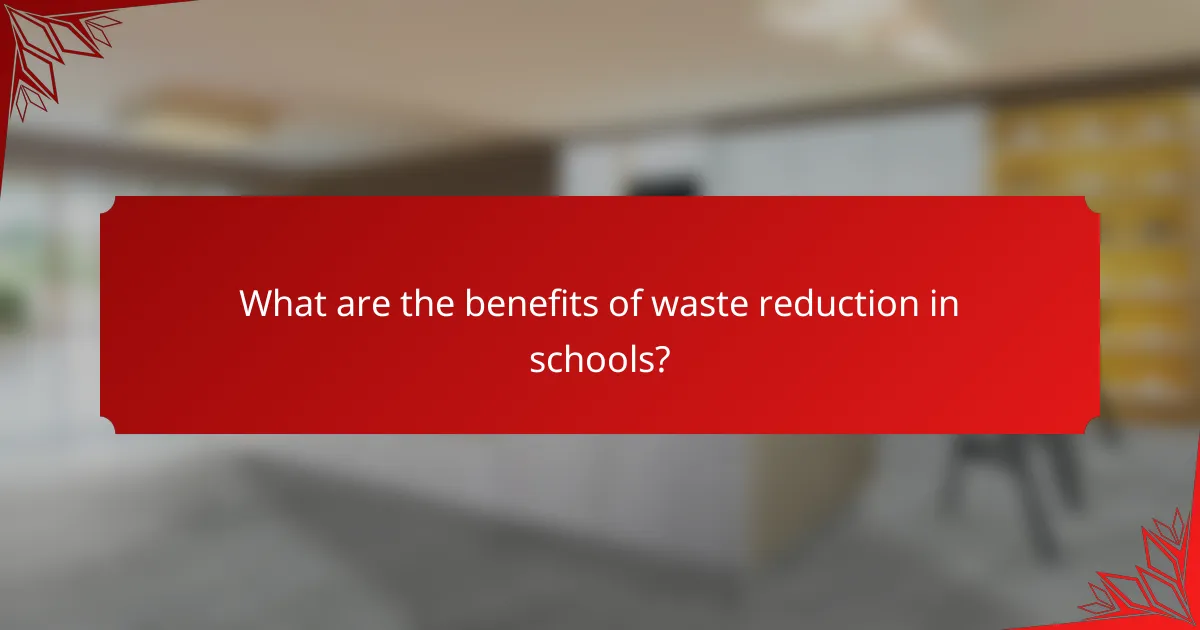
What are the benefits of waste reduction in schools?
Waste reduction in schools leads to significant environmental, financial, and educational advantages. By minimizing waste, schools can lower disposal costs, enhance student awareness, and positively influence their communities.
Cost savings on waste disposal
Reducing waste directly impacts the costs associated with waste disposal. Schools that implement effective waste reduction strategies can see a decrease in the volume of waste sent to landfills, leading to lower tipping fees and transportation costs.
For instance, a school that reduces its waste by 30% may save hundreds to thousands of dollars annually, depending on local disposal rates. Investing in recycling programs and composting can further amplify these savings.
Improved student engagement and awareness
Engaging students in waste reduction initiatives fosters a sense of responsibility and environmental stewardship. Programs that involve students in recycling and composting activities can enhance their understanding of sustainability and its importance.
Schools can organize competitions or projects that encourage students to track their waste output, promoting teamwork and critical thinking. Such hands-on experiences not only educate but also empower students to make environmentally conscious choices.
Positive community impact
Waste reduction efforts in schools extend beyond the campus, positively affecting the surrounding community. When schools adopt sustainable practices, they set an example for local residents and businesses, encouraging broader participation in waste reduction and recycling initiatives.
Collaborative projects, such as community clean-up days or recycling drives, can strengthen community ties and raise awareness about environmental issues. Schools can also partner with local organizations to create programs that benefit both students and the community at large.
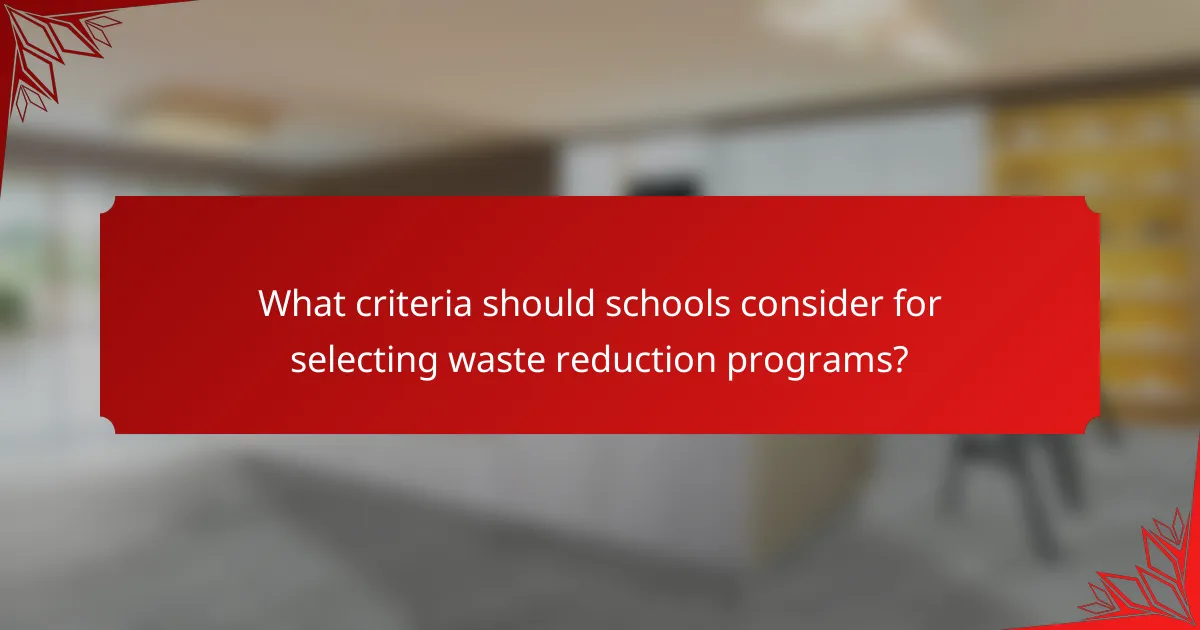
What criteria should schools consider for selecting waste reduction programs?
Schools should prioritize programs that are effective, adaptable, and supported by the community. Key criteria include the program’s scalability, sustainability, and the level of involvement from students, staff, and local stakeholders.
Program scalability and sustainability
When selecting waste reduction programs, consider how easily they can be scaled up or adapted to fit the school’s needs. Programs should have the potential to grow with the school population and be sustainable over time, minimizing the need for constant reinvestment.
For example, a recycling program that starts with paper and cardboard can be expanded to include plastics and metals as resources allow. Schools should also evaluate the long-term costs versus benefits, ensuring that the program remains financially viable.
Community involvement and support
Engaging the community is crucial for the success of waste reduction initiatives. Schools should seek programs that encourage participation from students, parents, and local organizations, fostering a sense of ownership and responsibility towards waste management.
Consider organizing workshops or events that educate the community about waste reduction and recycling. Collaborating with local businesses for sponsorship or resources can also enhance program effectiveness and sustainability.
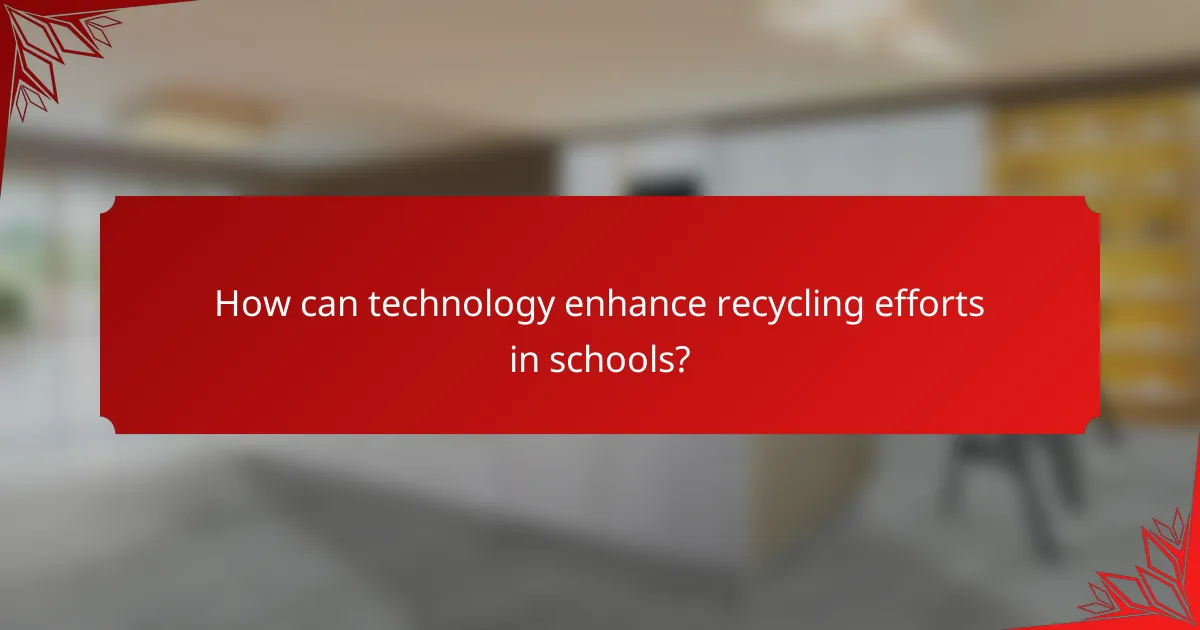
How can technology enhance recycling efforts in schools?
Technology can significantly improve recycling efforts in schools by providing tools for tracking progress and engaging students. By utilizing mobile apps and digital platforms, schools can foster a culture of sustainability and accountability among students and staff.
Mobile apps for tracking recycling progress
Mobile apps designed for tracking recycling progress allow schools to monitor their waste management efforts in real-time. These applications can provide insights into the amount of recyclable materials collected, helping to identify trends and areas for improvement.
For effective implementation, schools should consider apps that offer features like gamification, where students earn rewards for recycling milestones. This approach can motivate students to participate actively in recycling initiatives.
Digital platforms for student engagement
Digital platforms can enhance student engagement by creating interactive experiences around recycling and waste reduction. Schools can use websites or social media to share educational content, host challenges, and celebrate achievements in recycling.
To maximize impact, schools should encourage students to create content, such as videos or blogs, showcasing their recycling efforts. This not only raises awareness but also fosters a sense of ownership and pride in their contributions to sustainability.
